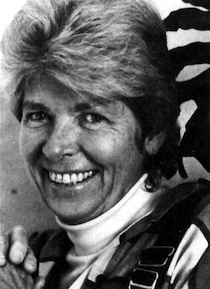Opening the Lotus: A Woman’s Guide to Buddhism
Sandy Boucher
Beacon Press: Boston, 1997
224 pp., $20.00 (hardcover)

The wheel has turned a few times since 1988, when Turning the Wheel, Sandy Boucher’s survey of Buddhist women teachers and community members in the United States, shocked the public by indicating that women have points of view within, and upon, Buddhism. And these, she argued, are specific to women’s experience, and thus somewhat independent of received doctrine. It was an exuberant book, filled with descriptions of Western women teachers in their thirties with luminous eyes and extreme alertness, speaking excitedly to Boucher about how they were counteracting institutionalized patriarchy in Buddhism.
Eleven years later, Boucher returns with Opening the Lotus a gentler and humbler work addressed to beginners rather than committed sangha members; and to women, rather than both sexes. This book is a sadder and wiser one. At the very end, Boucher discloses a bout with cancer. Her tone is quiet, patient, trustworthy, acknowledging difficulties rather than crusading against them. Instead of warning women against the dangers of Buddhism, she invites newcomers to taste its benefits.
Boucher assuages a neophyte’s possible fears by describing the shape of the meditation cushions at a vipassana center, and the personal testimonials at a Sokka Gakkai center. She explains refuges and precepts, and gives several kinds of meditation instructions that anyone can work with. Then she tackles those scary topics like sexual abuse by teachers, and addresses nagging questions like why Buddhism seems to focus on suffering, whether detachment is a bad thing to cultivate, and whether it’s dangerous for women to practice compassion (when so many women’s mental balance depends on their learning to take better care of themselves). Readers may not agree with Boucher’s analyses, but in general her carefulness is apparent, and respectable. With an engaging humility, each chapter contains personal reminiscences of her own difficulties and triumphs in practice. Typical is a confession about how difficult it was to meditate after drinking mimosas at brunch; typical, too, is the care with which Boucher explains what, exactly, a mimosa is.
Since I was interested in the book, but not a beginner, I found myself wondering who exactly Boucher’s audience would be. Much of what she said would be equally interesting to men as to women. It’s becoming easy to say at this postmodern point in culture that we no longer need a Buddhist book just for women. However, until race and gender are no longer generally considered valid ways of classifying and identifying the complexity of human beings, books that address the concerns of one sub-community will be written.
Within Buddhism itself, the range of Boucher’s concerns is not limited to things that a neophyte would want to know. Would the same person who doesn’t know the composition of a mimosa be able to hear without prejudice Boucher’s recollection of her life as a lesbian? And would the person who wants to know the shape of the cushions at a vipassana center also be interested in the history of the early monastic order in India? There’s no reason why not, but in the end, I decided that Boucher was instructing her own younger self, telling herself what she had learned, offering warnings and encouragements she wished she’d had at the beginning of her Buddhist practice. Boucher now invites others to come inside Buddhism and see its rewards. Perhaps she is a little too eager to minimize the problems, to make everything seem workable. At times her quiet tone of voice seems a little strained, muted, like someone speaking in a whisper for so long they forget they’re doing it. It can be hard to know whether what she’s saying is too soothing or too outrageous, such as when she says that while there may be “residual homophobia” at some Buddhist centers, “same-sex relationships are as accepted within Buddhist environments as heterosexual unions.” While it’s true that Buddhist environments tend to be islands of tolerance of a kind not easily found in the outside world, still, a gay couple might feel themselves misled if they wandered into most any Buddhist center assuming they’d find a high level of tolerance for gay expressions of sexuality. And though it’s true that the most basic Buddhist texts don’t discriminate against homosexual sex, gauging, as Boucher says, only whether the relationship is beneficial, even His Holiness the Dalai Lama has been heard to inveigh against sex in the wrong orifices.
In the end, it is Boucher’s simplicity which allows her to reach beginners and broken-in Buddhists alike. For example, Boucher anticipates the discomfort many beginners feel when they encounter the notion of suffering in Buddhist philosophy. Does Buddhism force us to suffer more than usual? What, exactly, is meant by “suffering”? Boucher’s answer to these typical questions is vivid and concrete. She invites us to imagine a fly landing on our faces while we meditate. This common experience is accessible to anyone’s imagination, and it is nearly universally, undeniably uncomfortable, even for people who have practiced meditation for many years. By extension, we may not have exhausted our questions about how Buddhism fits into our lives, or how our lives fit into Buddhism, even after many years. Boucher’s book suggests that when these material or immaterial flies land on us, if we persist in living by Buddhist principles, our responses may well become a good deal gentler.
Thank you for subscribing to Tricycle! As a nonprofit, we depend on readers like you to keep Buddhist teachings and practices widely available.